Since
the beginning of Israel’s bombardment of the Gaza Strip, innumerable treasures
of Palestine’s cultural heritage have been damaged or destroyed. Like
so much of the rest of the besieged enclave, these priceless and beloved
landmarks of our people’s history — archaeological sites, millennia-old
religious structures, and museums with ancient collections — now lie in
ruin.
اضافة اعلان
Cultural
heritage is an essential component of a nation’s identity and carries enormous
symbolic meaning, as recognized and protected by countless international
conventions, treaties, and bodies. Yet
Israel’s pounding of Gaza, now in
its fifth month, displays a callous disregard for these testaments to the
thousands of years of Gaza’s rich cultural history — to such an extent that it
could amount to
cultural genocide.
Researchers
are trying desperately to catalog these sites and ascertain their current
status, but are unable to keep up with the pace of the carnage. And while the
loss of human life is the greatest tragedy in any war, Israel’s destruction of
Gaza’s physical cultural heritage achieves much the same goal: the erasure of
the Palestinian people. Indeed, many of those interviewed for this article
believe this is precisely why these sites are being targeted.
National treasures
Hamdan
Taha is a renowned scholar, archeologist, and the former Director General of
the Palestinian Department of Antiquities in Gaza. In an interview with +972
Magazine, after he managed to leave the Strip, he underscored the profound
historical and civilizational role played by Palestine in general, and Gaza in
particular, despite their small geographic size.
“Gaza
has witnessed cultural intermingling where civilizations have intertwined,
giving rise to a rich and diverse cultural heritage,” he explained. Taha
pointed in particular to Gaza’s port, which for centuries was a major hub of
trade across the Mediterranean and a locus of this multiculturalism.
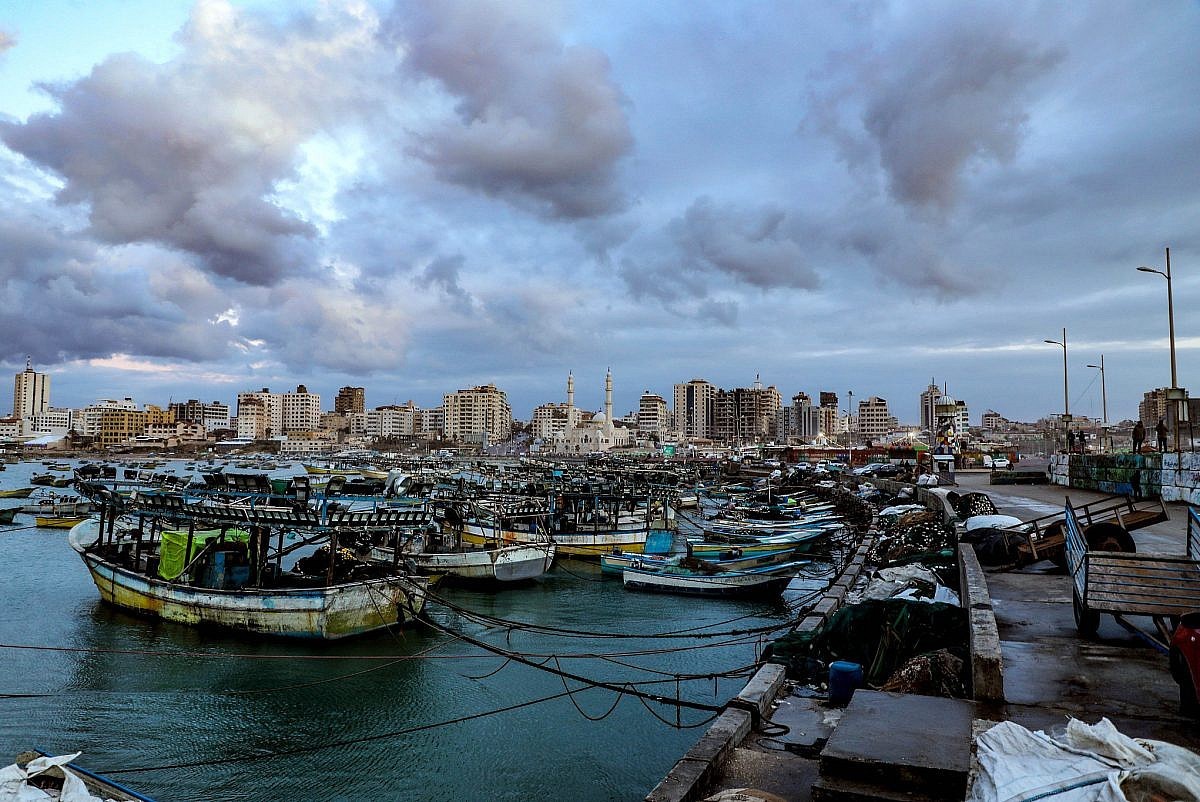 Gaza’s port on January 9, 2020. (Mohammed Zaanoun/Activestills/+972 Magazine)
Gaza’s port on January 9, 2020. (Mohammed Zaanoun/Activestills/+972 Magazine)
“Cultural
heritage reflects our national identity,” he continued. “It is the witness to
the historical and civilizational epochs our homeland has traversed. It is a
national treasure.”
According
to Taha, the national significance of these sites, and their potential to bring
tourism and lift Gaza’s economy, “led Israel to intentionally tamper with
historical and archaeological buildings, aiming to obliterate the connection
between the people of Gaza and their land and history.” Israel, Taha added,
“wants to disconnect the people of Gaza from the history of the land, while
consistently trying to create its own narrative and association with the
place.”
During
the 2014 war on Gaza, Taha and other archaeologists formed a committee to
formally assess the damage caused by Israel’s attacks. They worked to restore
and catalog all of Gaza’s antiquities, in part to be prepared for future
bombardment. Yet the scale of the current war has overwhelmed their efforts.
Given
the continual bombardment of the Strip since October 7, it has been
extraordinarily difficult for Taha and other experts to assess the extent of
the damage — despite the best efforts of Palestinian and foreign scholars who
are monitoring the situation remotely.
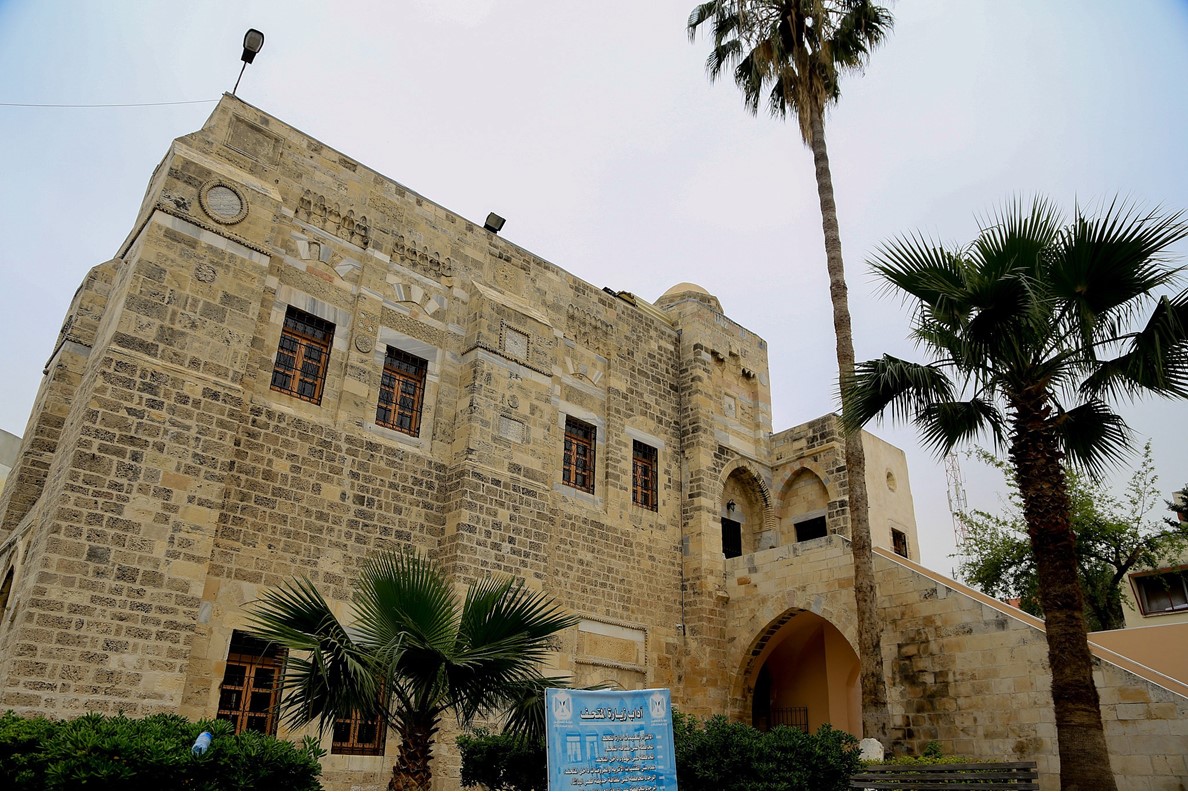 Qasr al-Basha (Pasha Palace), the 13th century historic building located in the old quarter of Gaza City. (Omar El Qattaa)
Qasr al-Basha (Pasha Palace), the 13th century historic building located in the old quarter of Gaza City. (Omar El Qattaa)
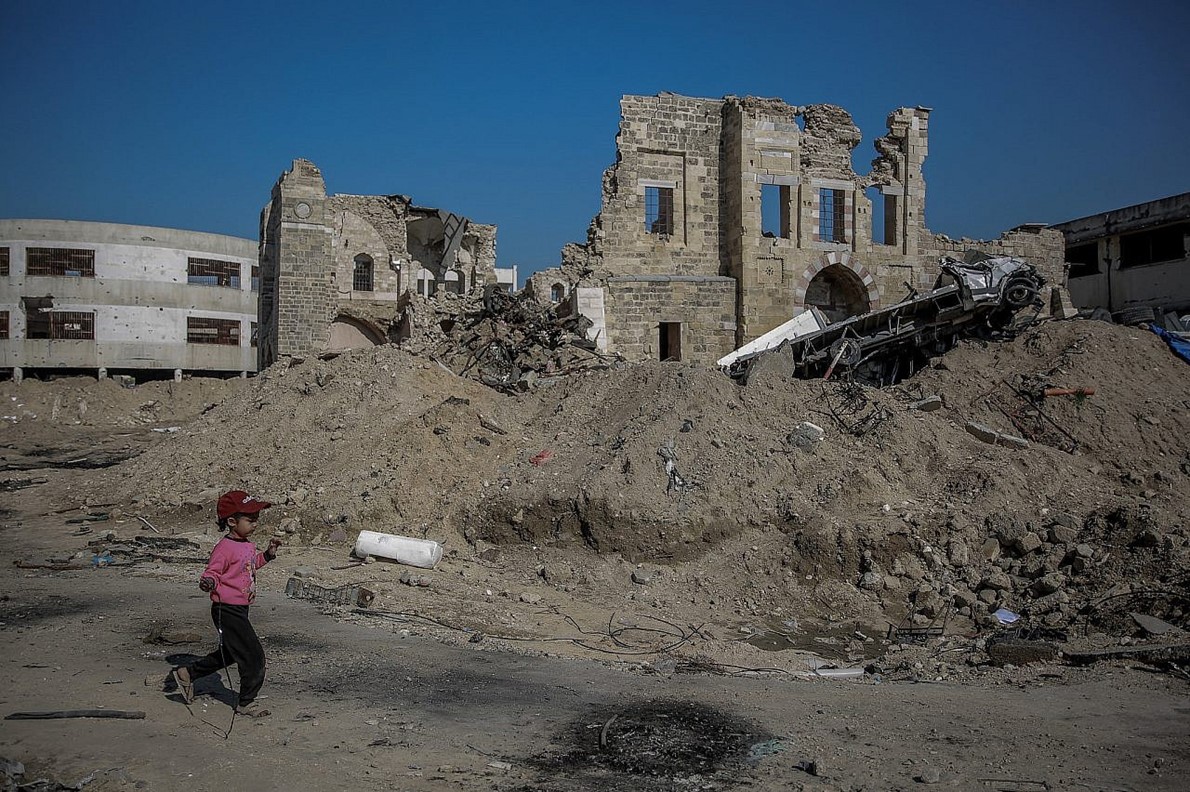 The ruins of Qasr al-Basha (Pasha Palace), February 12, 2024. (Omar El Qattaa)
The ruins of Qasr al-Basha (Pasha Palace), February 12, 2024. (Omar El Qattaa)
“Most
of the information we obtain comes from journalists and individuals who capture
scenes either coincidently or by passing through the location,” he explained.
“And we rely on information provided by residents living in the vicinity of the
targeted areas and on breaking news reports.” From these accounts, it appears
that Israel’s bombing has left little behind.
‘It is challenging for experts
to keep track while being targeted’
One
of the photojournalists documenting this wreckage is Ismail Al-Ghoul, who is
currently residing in Gaza City and reporting for Al Jazeera. He photographed
the ruins of the 1,600-year-old Byzantine Church in the Jabalia district, and
the Hammam Al-Sammara — a centuries-old bathhouse in the Zeitoun
neighborhood.
“The
last remaining historical bath in the Gaza Strip, with a history spanning
nearly a thousand years, now lies in total ruins,” he lamented. “Most people in
Gaza have visited this bath and had a beautiful, unforgettable experience. Even
visitors to Gaza sought a glimpse of its famous healing and therapeutic
properties.”
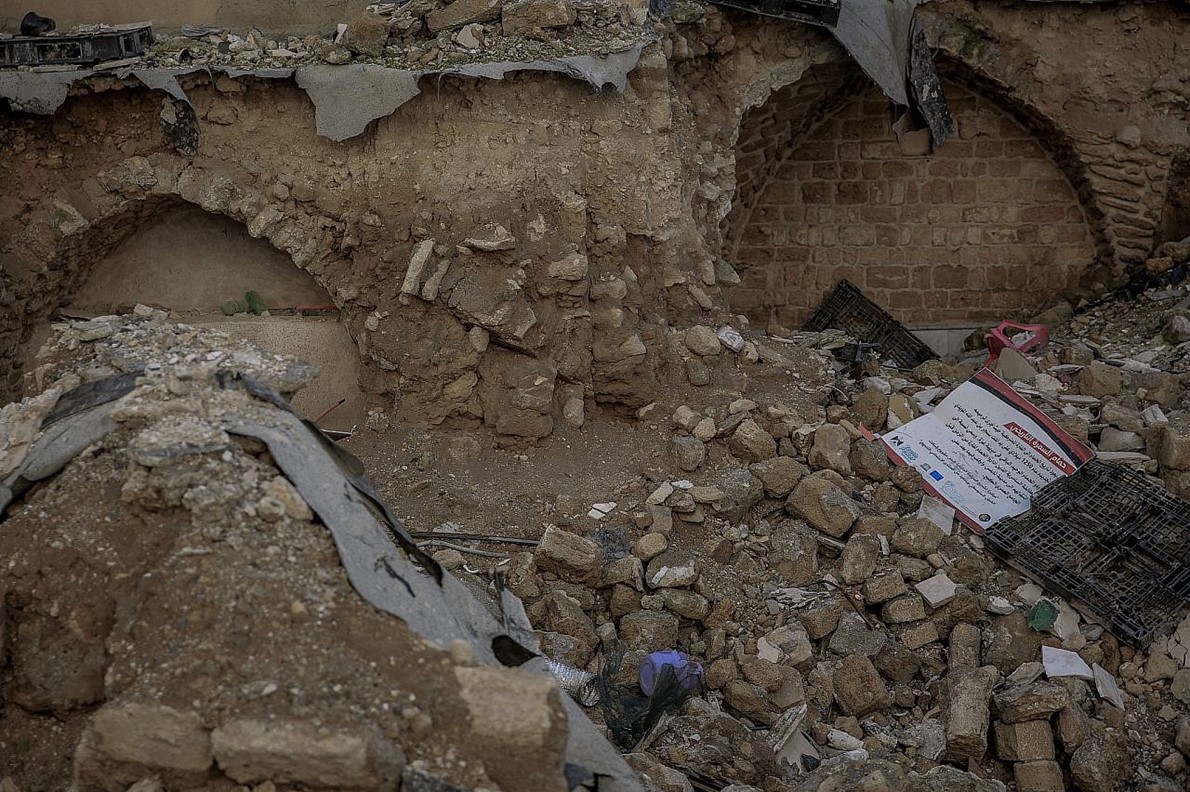 The ruins of Hammam al-Sammara — a centuries-old bathhouse in the Zeitoun neighborhood of Gaza City, February 12, 2024. (Omar El Qattaa)
The ruins of Hammam al-Sammara — a centuries-old bathhouse in the Zeitoun neighborhood of Gaza City, February 12, 2024. (Omar El Qattaa)
Al-Ghoul
also photographed the ruins of the 13th-century
Qasr Al-Basha (Pasha
Palace), which was distinctive for the remarkable preservation of its
architectural details. More than 90 percent of the palace was destroyed by
Israeli bombing and subsequent bulldozing, leaving only a small portion still
standing.
Despite
the devotion of photojournalists like Al-Ghoul, the war has made it impossible
to document the full extent of the damage. “It is challenging for experts to
keep track while being in a state of displacement themselves, being targeted,
and continually moving from one place to another,” Taha explained. “We have
lost more than 10 antiquities experts, including four archaeologists.”
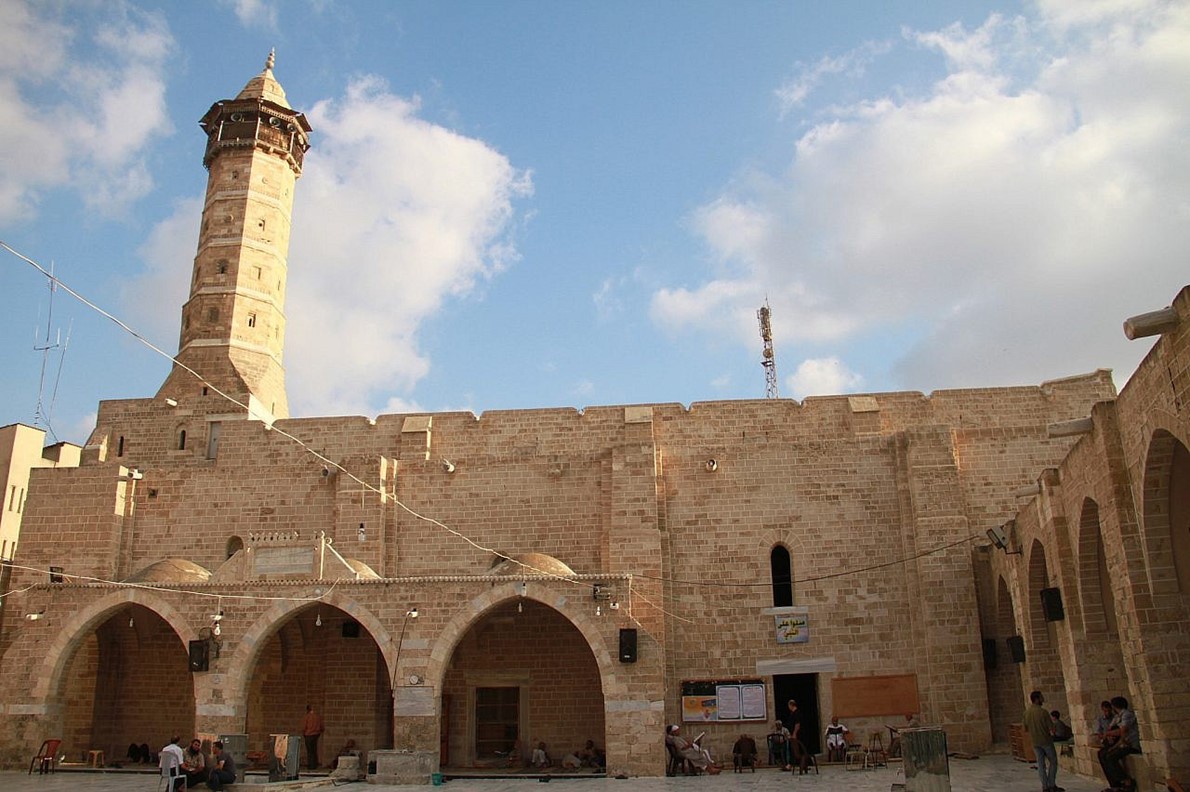 The Great Omari Mosque, the largest and oldest mosque in northern Gaza. (Omar El Qattaa)
The Great Omari Mosque, the largest and oldest mosque in northern Gaza. (Omar El Qattaa)
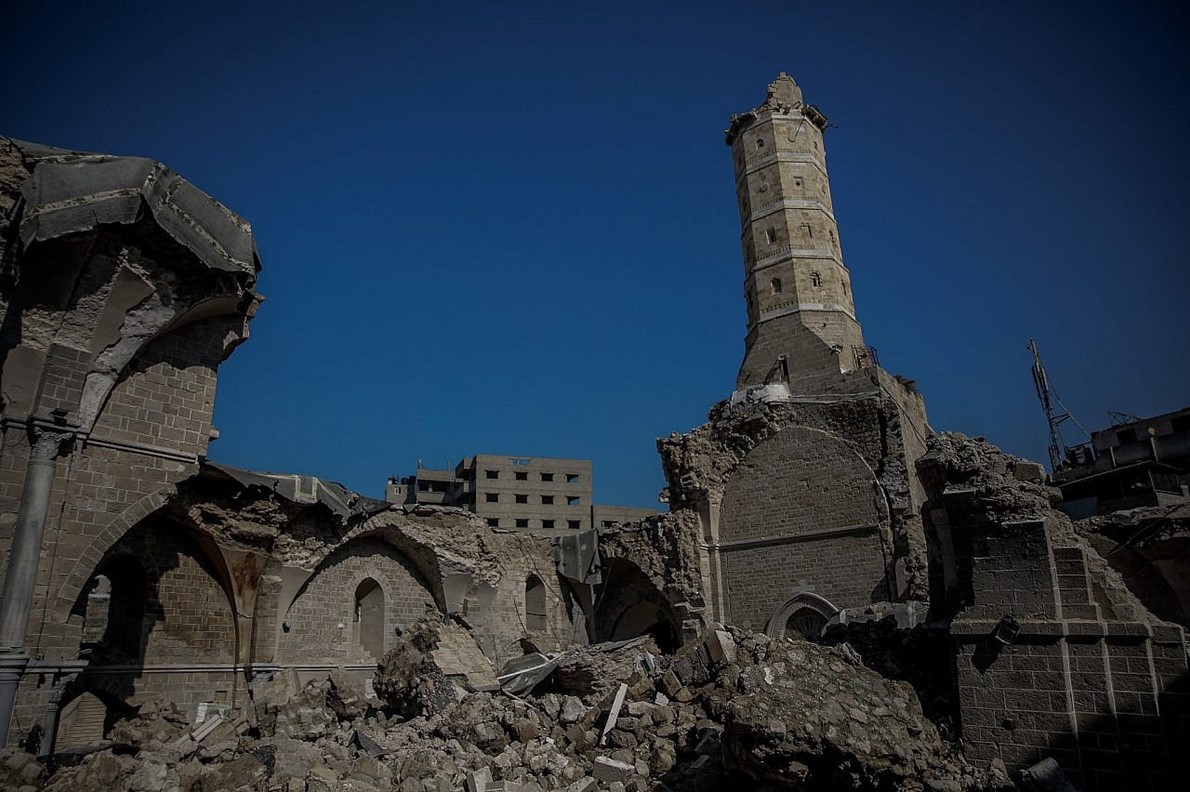 What is left of the Great Omari Mosque, the largest and oldest mosque in northern Gaza, February 12, 2024 (Omar El Qattaa)
What is left of the Great Omari Mosque, the largest and oldest mosque in northern Gaza, February 12, 2024 (Omar El Qattaa)
Among
the other heritage sites that are confirmed to have suffered severe damage is
the
Great Omari Mosque — the largest and oldest in northern Gaza,
with a history which, according to some accounts, dates back 2,500 years. The
entire structure has been destroyed, save only for its minaret. The mosque
embodied the rich and diverse history of the Strip: originally an ancient pagan
temple, it was later transformed into a Byzantine church, and eventually
converted into a mosque during the Islamic conquests.
Gaza
City’s Sayyed Hashim Mosque has also been badly damaged. Located in the old
town, the mosque housed the tomb of Hashim Ibn Abd Manaf — the grandfather of
the Prophet Muhammad, who is so closely identified with the city that it is
often referred to in Palestinian literature as “Gaza of Hashim.”
The
Church of Saint Porphyrius, locally referred to as the “Greek Orthodox
Church” — which, built in 425 AD, is one of the oldest churches in the world —
was damaged too, and one of the buildings inside the church’s vicinity was
completely destroyed.
Taha
stressed that the damage has not been confined solely to the north of the
Strip. The
Rafah Museum in southern Gaza — the only museum in the
area — has been completely destroyed. Al-Qarara Museum near Khan Younis, which
had a collection of about 3,000 artifacts dating back to the Canaanites, the
Bronze Age civilization that lived in Gaza and across much of the Levant in the
second century BC, was badly damaged. The shrine of Al-Khader in the central
city of Deir Al-Balah, which holds special significance as the first and oldest
Christian monastery built in Palestine, was also damaged when an area nearby
was bombed.
All
over the Strip, Israel has damaged and destroyed secular historical sites as
well as those affiliated with Islam and Christianity. Everything is a target.
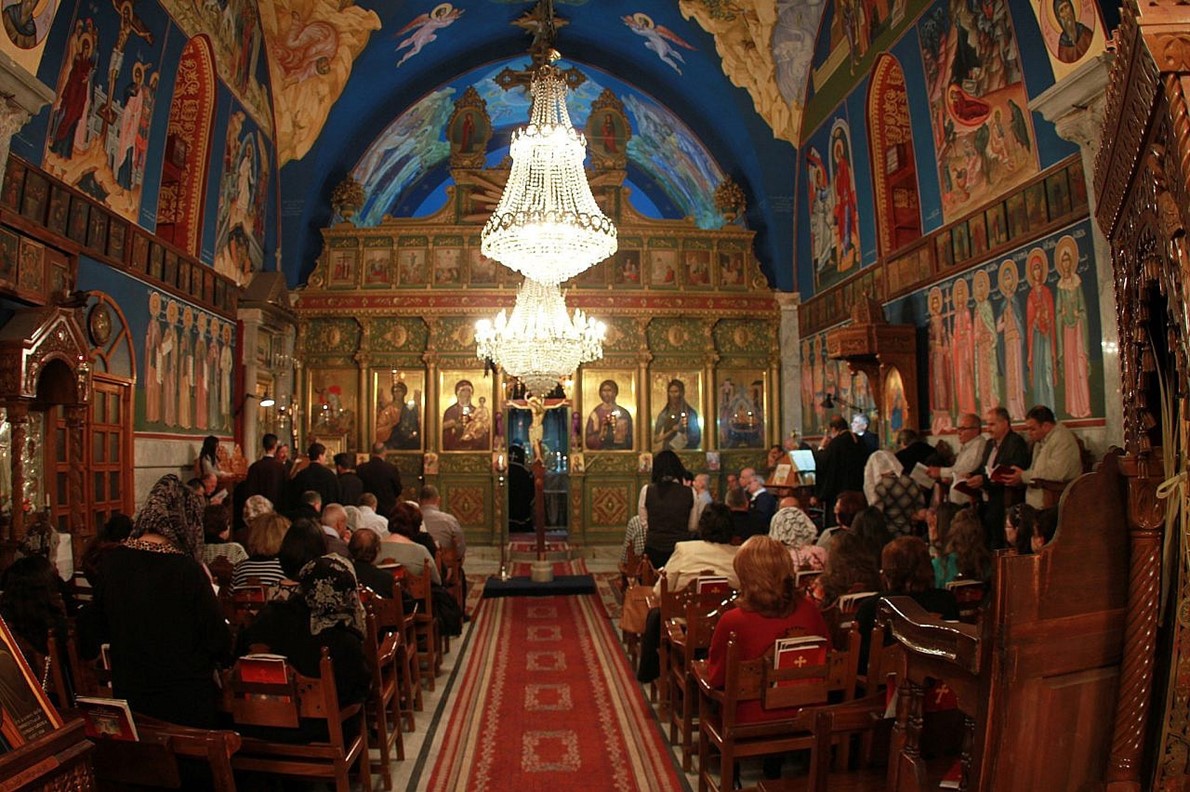 A mass at the Church of Saint Porphyrius, locally referred to as the “Greek Orthodox Church”, in Gaza City. (Omar El Qattaa)
A mass at the Church of Saint Porphyrius, locally referred to as the “Greek Orthodox Church”, in Gaza City. (Omar El Qattaa)
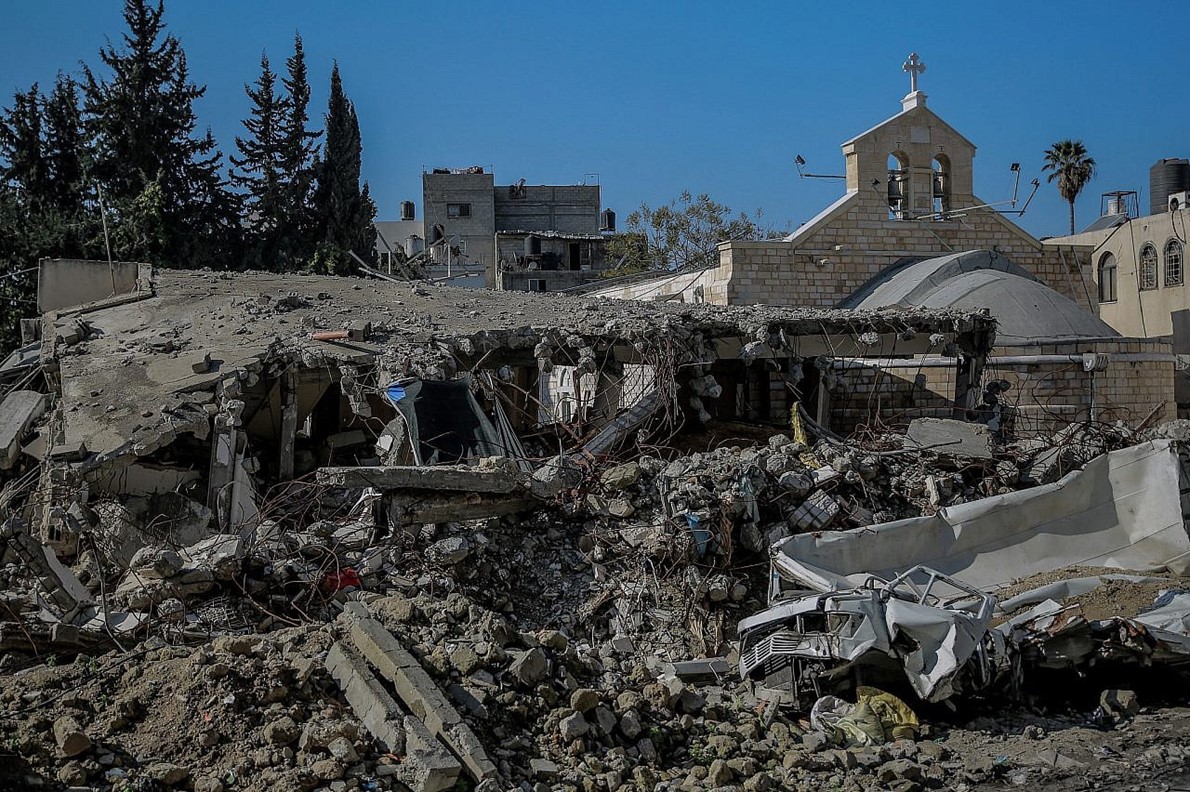 The damage in the vicinity of the Church of Saint Porphyrius, locally referred to as the “Greek Orthodox Church”, February 12, 2024. (Omar El Qattaa)
The damage in the vicinity of the Church of Saint Porphyrius, locally referred to as the “Greek Orthodox Church”, February 12, 2024. (Omar El Qattaa)
‘All of Gaza’s history is on the
verge of collapse’
Haneen
Al-Amassi, an archaeology researcher and the executive director of the Eyes on
Heritage Foundation that launched last year, sees the destruction of
archaeological sites as part of a broader campaign against Palestinian
life.
“Archaeological
sites are tangible, physical evidence attesting to the right of Palestinians to
the land of Palestine and their historic existence on it, from the Stone Ages
to the present day,” she told +972. “The destruction of these sites in the Gaza
Strip in such a brutal and systematic manner is a desperate attempt by the
occupation army to erase the evidence of the Palestinian people’s right to
their land.”
Al-Amassi
listed numerous significant losses. The
ancient port of Gaza, also known
as Anthedon Harbour or Al-Balakhiya, which dates back to 800 BC, has been
destroyed. Dar Al-Saqqa (Al-Saqqa House) in the Shuja’iya neighborhood of
eastern Gaza City, built in 1661 and considered the first economic forum in
Palestine, was badly damaged too.
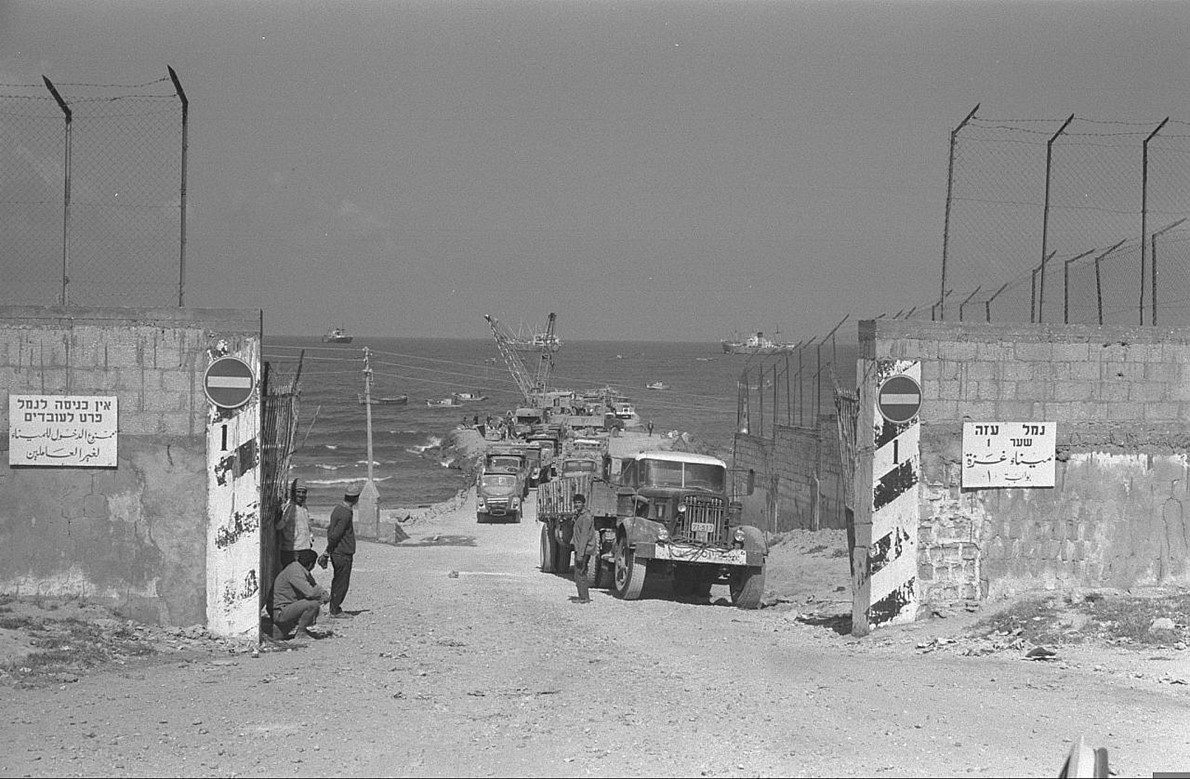 Entrance to the Port of Gaza, April 17, 1973. (Nissim Gabai/GPO)
Entrance to the Port of Gaza, April 17, 1973. (Nissim Gabai/GPO)
The
destruction of these landmarks and archaeological sites, Al-Amassi stressed,
represents a significant loss for the Palestinian people — one that will be
difficult, if not impossible, to compensate for. “It is impossible to restore
these monuments in the face of continuous bombing,” she said. “And with the
shameful silence of international actors, there will only be more bombings of
archaeological sites in Gaza. All its history and sanctity is on the verge of
collapse.”
Even
when they are not the primary target of Israeli bombings, archaeological sites
are still being badly damaged. Al-Amassi mourned the Khoudary Museum, also
known as Mat’haf Al-Funduq (Museum Hotel) in northern Gaza, which housed
thousands of unique archaeological pieces, some dating back to the Canaanite
and Greek periods; the museum was significantly damaged by the bombing of the adjacent
Khalid ibn Al-Walid Mosque.
Similarly,
the Khan of Amir Younis Al-Nawruzi, a historic fort built in 1387 in the center
of the southern city of Khan Younis, was damaged when the nearby municipality
building was bombed. The
Monastery of Saint Hilarion at Tell Umm
El-Amr near Deir Al-Balah, which dates back more than 1600 years, and Gaza
City’s Al-Ghussein House, a historic building dating back to the late Ottoman
period, were both also damaged when nearby areas were bombed.
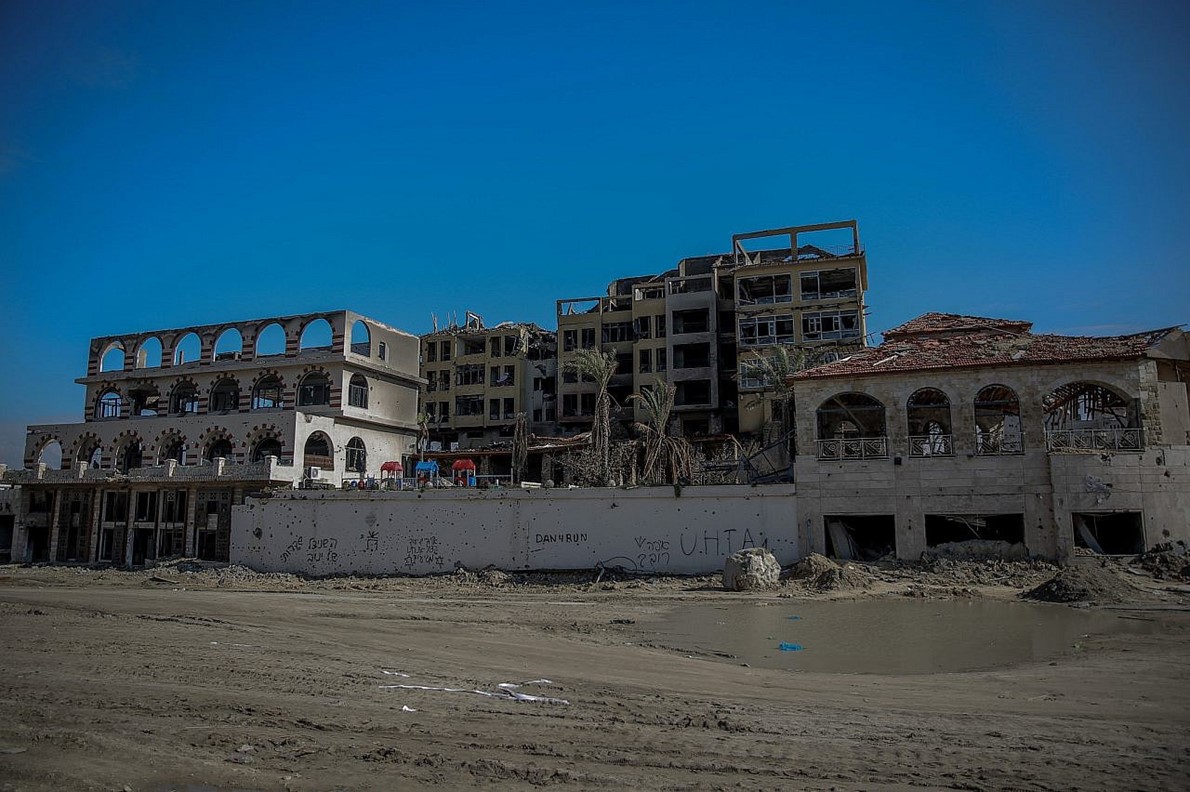 The Khoudary Museum, also known as Mat’haf al-Funduq (Museum Hotel) after the Israeli bombardment of the area, February 12, 2024. (Omar El Qattaa)
The Khoudary Museum, also known as Mat’haf al-Funduq (Museum Hotel) after the Israeli bombardment of the area, February 12, 2024. (Omar El Qattaa)
The
Geneva-based Euro-Med Human Rights Monitor has
accused Israel of
“clear intentional targeting of all historical structures in the Gaza Strip.”
Gaza’s Ministry of Tourism and Antiquities stated similarly in a press release
in late December, “The occupation is deliberately committing a massacre against
historical and archaeological sites in Gaza City’s old town, assassinating
history and the traces of civilizations that have passed through the Gaza Strip
for thousands of years.”
Such
destruction, whether targeted or not, is a violation of the
1954 Hague Convention, which seeks to protect cultural heritage during both peace and war.
Al-Amassi hopes the Palestinian Authority will include these violations in
its
petition to the International Criminal Court (ICC).
A sharp acceleration of
longstanding practices
As
numerous researchers pointed out, the ongoing destruction in Gaza is of a piece
with Israel’s longstanding practices of erasure and appropriation. Eyad Salim,
a historian and archaeological researcher from Jerusalem, listed several
heritage sites that have been destroyed by Israeli Occupation Forces (IOF)
since the Nakba of 1948.
“In
the Palestinian villages destroyed in 1948, mosques, Islamic shrines, and
heritage sites were either closed, destroyed, or converted into synagogues,” he
said. “This is a long and extensive issue.”
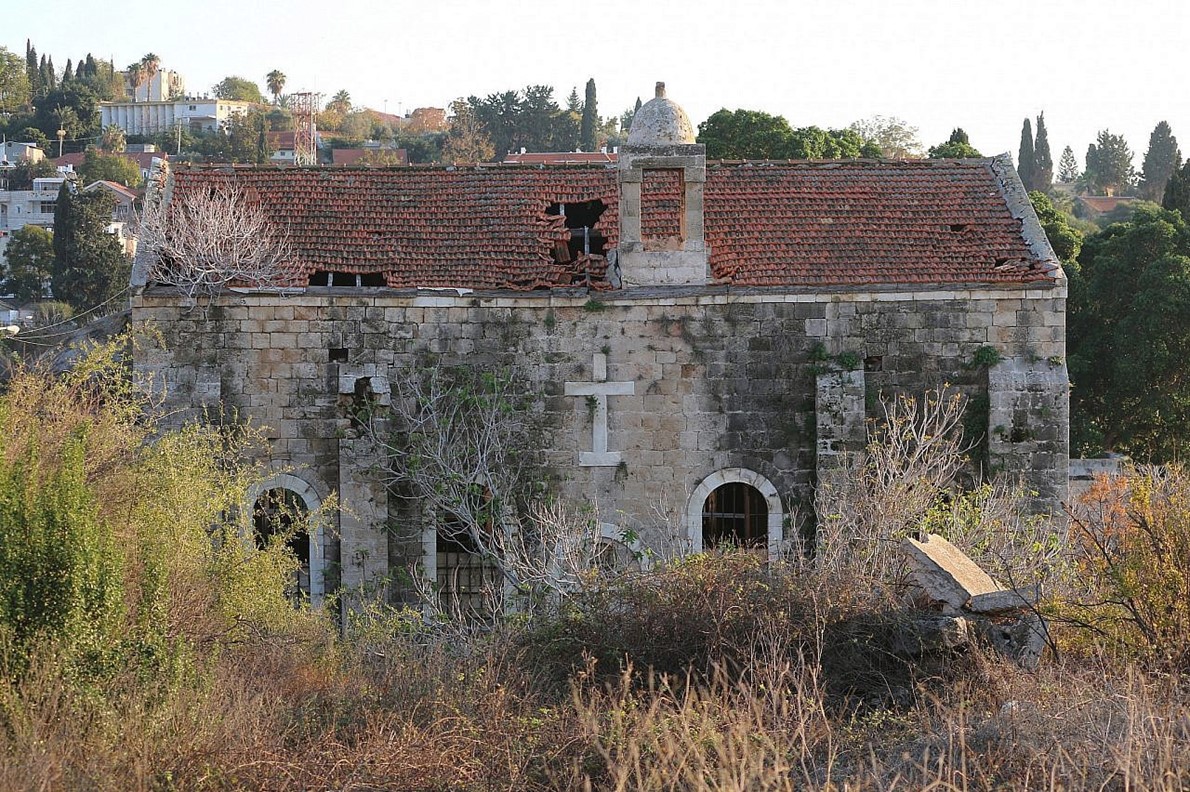 A damaged church is seen in the depopulated al-Bassa village, in the north. Most of its residents became refugees living in camps in Lebanon. (Ahmad Al-Bazz)
A damaged church is seen in the depopulated al-Bassa village, in the north. Most of its residents became refugees living in camps in Lebanon. (Ahmad Al-Bazz)
Other
examples include
the razing of the Sharaf and Mughrabi neighborhoods
of Jerusalem’s Old City in the aftermath of the 1967 War in order to create a
plaza in front of the Western Wall, in addition to
many tombs of
righteous Muslims. Salim points out that various state bodies — the military,
the Antiquities Authority, and the Civil Administration — have all played a
role in this destruction and appropriation.
“To
implement its plan to build the ‘Jewish state,’ Israel faces identity,
geographic, and demographic challenges,” he continued. “So it attributes
[Palestinian] cities, villages, urban landmarks, fashion, food, handicrafts,
and traditional industries to itself, promoting them in international fora and
using them as part of its Judaizing project.”
Much
of this erasure occurs subtly, by simply making it difficult for Palestinian
cultural heritage institutions to survive. This is particularly evident in
Jerusalem, Salim explained, where the Municipality charges unreasonably high
taxes, surveils cultural institutions, arbitrarily demands information, blocks
funding, threatens them with closure, and bans any indication of official
Palestinian government support for Jerusalem institutions.
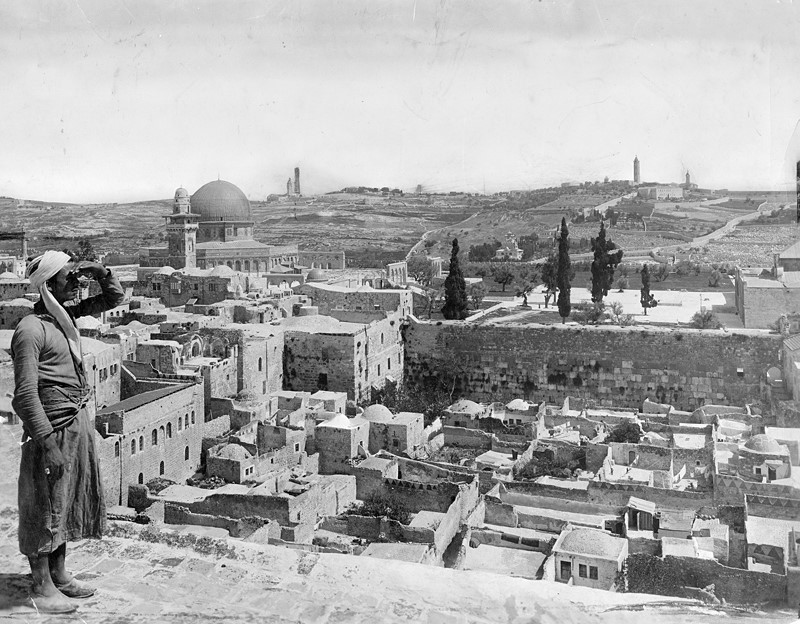 The Western Wall and the Mughrabi Quarter, which was destroyed following Israel’s capture of Jerusalem’s Old City during the 1967 War, taken between 1898 and and 1946. (American Colony Photo Department)
The Western Wall and the Mughrabi Quarter, which was destroyed following Israel’s capture of Jerusalem’s Old City during the 1967 War, taken between 1898 and and 1946. (American Colony Photo Department)
What
we are currently witnessing in Gaza, however, is a sharp acceleration in
Israel’s erasure of Palestinian heritage. The rapid destruction of so many
treasured sites during the first weeks of the war quickly became a concern for
archaeologists and researchers across the Arab world.
On
November 11-12, Egypt hosted the
Arab Archaeologists League’s 26th
International Conference of Arab Archaeologists, which was centered around
solidarity with the people of Gaza.
Representing
Palestine was Husam Abu Nasr, a historian from Gaza who happened to be
accompanying his mother for medical treatment in Egypt when the war broke out.
Abu Nasr presented a report on the museums in the Strip that had been damaged
up to that point in the war, and the League established a fund to support the
rebuilding and restoration of all heritage sites and institutions, as well as
all educational institutions that have been destroyed in Gaza. It also promised
to advise on restoration efforts when the war comes to an end.
“Through
targeting historical buildings and sites, archaeologists, academics, and
researchers, Israel seeks to erase Palestinian identity, and particularly Gazan
identity, and make it devoid of history and civilization,” Abu Nasr told +972.
“Israel wants to erase our national memory, to promote the distortion of facts,
and fight against the Palestinian narrative.” Doing so, he emphasized, is a
violation of international and humanitarian law.
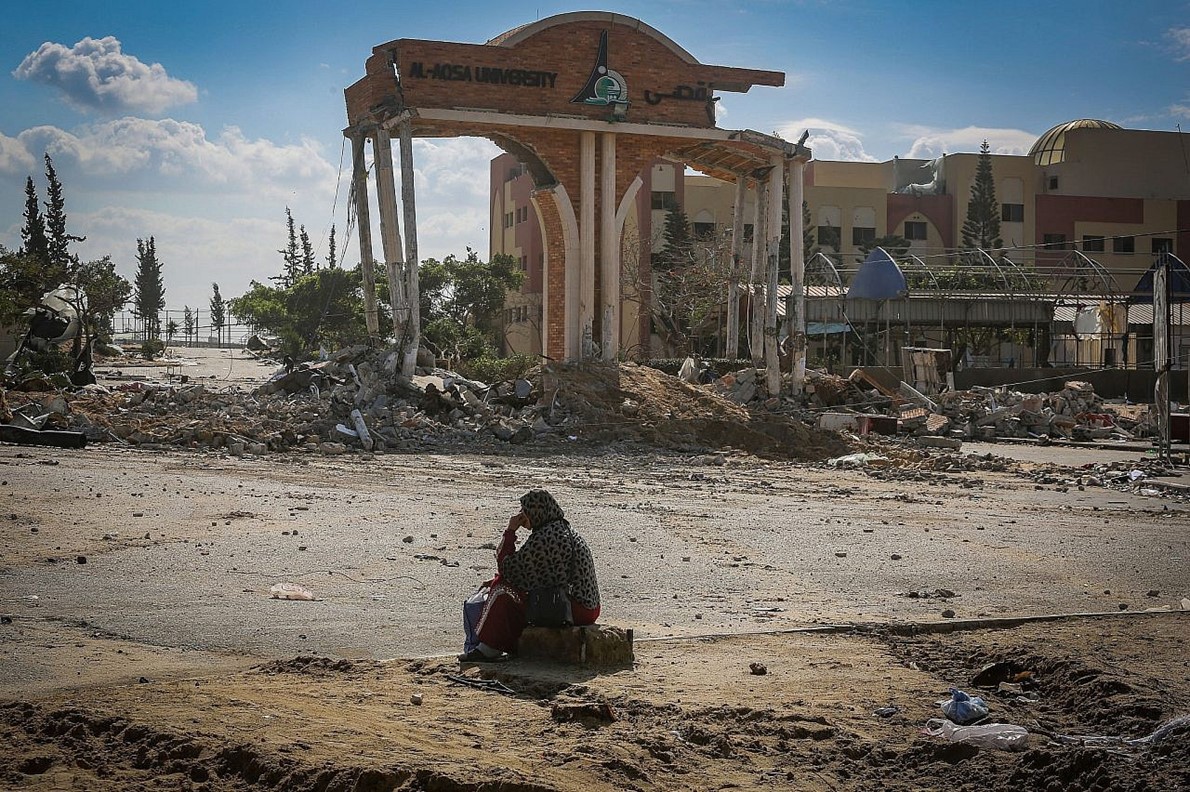 A Palestinian woman sits in front of the damaged entrance to Al-Aqsa University in Khan Younis, southern Gaza Strip, January 26, 2024. (Atia Mohammed/Flash90)
A Palestinian woman sits in front of the damaged entrance to Al-Aqsa University in Khan Younis, southern Gaza Strip, January 26, 2024. (Atia Mohammed/Flash90)
Putting
Israel’s destruction of Gaza’s heritage in perspective, Taha emphasized that
“human lives are the most important thing, and nothing comes before that. But
at the same time, preserving and protecting heritage and culture is an integral
component of protecting the people and their spirit.
“Not
only the Palestinians in Gaza but humanity as a whole will suffer a great loss
if Israel continues to destroy cultural heritage in the Gaza Strip without
facing consequences.”
In
a statement to +972, the IOF Spokesperson said, “The IOF avoids damage to
antiquities and historical sites as much as possible. As documented and
presented by the IOF during the war, Hamas’ assimilation into and use of the
civilian environment is on a large and unprecedented scale.
“Hamas
is systematically using public buildings which serve civilian purposes,
including government buildings, educational institutions, medical institutions,
religious buildings, and heritage sites,” the statement continued. “As part of
the destruction of Hamas’s military capabilities, there is, among other things,
an operational need to destroy or attack structures in which the terrorist
organization places a combat infrastructure. This includes structures that
Hamas has regularly converted to fighting. The IOF is committed to
international law and acts according to it and IOF values.”
Ibtisam Mahdi is a freelance journalist from Gaza
specializing in reporting about social issues, especially concerning women and
children. She also works with feminist organizations in Gaza on reporting and
communications.
This essay was published first by +972 Magazine on February 17, 2024.
Read more Opinion and Analysis
Jordan News
















